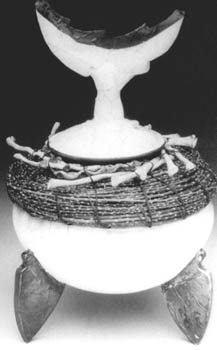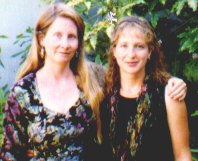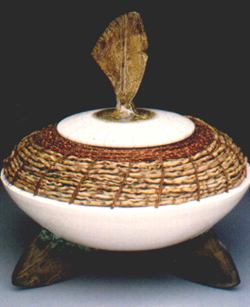|
|
|
| ||
| Espaņol |
Currently only excerpts & illustrations from the last 13 issues (numbers 43 to 55) are on this site. Scroll down to view the March 1999 issue. Click on the numbers to view other issues. Info about the current book on the arts | |||||||||||||||||||||||||||||||||||||||||||||||
| Contents List | |||||||||||||||||||||||||||||||||||||||||||||||
| excerpts & illustrations (The full articles are only available in the printed magazine. Click on "subscribe" for more info.) |
 |
56 |  |
55 |  |
54 |  |
 |  |
53 |  | 52 |  |
51 |  |
 |
 |
50 |  |
49 |  |
48 |  |
47 |  |
 |  |  |  |
 | ||||||||||||||||||
 |
 |  |
 | ||||||||||||||||||||||||||||||||||||||||||||
| 46 |  |
45 |  | 44 |  |
43 |  |  |
 | 42 |  | 41 |  | 40 |  | 39 |  |
 | 38 |  | 37 |  |
36 |  | 35 |  |
 |  |
34 |  |
33 |  | 32 |  | 31 |  | |||||||||||
number 47
|

|
Splendor and Beauty ceramic by Chris Clay basketry by Suzette Nyokka, U.S.A. |
|||||||||||||||||||||||||||||||||||||||||||||
|
International festival of women´s theatre, Wellington, March 29 -
April 3rd, 1999.
An international festival of voice:A Divinity of the Voice April 1 - 10th, 1999 Wales, UK. An international round-up of tutors/instructors over 40 names from all over the globe. More info: http://www.aber.ac.uk/~cprwww or email: Fiona Smith, Centre for Performance Research, cprwww@aber.ac.uk The Island of the Same Name by Joseph Sheppherd "This debut novel by the Bahá´í author Joseph Sheppherd follows the adventures and discoveries of two generations of researchers: an archaeologist named Hemet Recuero Holden and his daughter Maya Lillian Holden, an anthropologist. Each in turn, visits the same African island, but each discovers vastly different things. Hemet uncovers the remnants of an intriguing culture, and meets the sole survivor of a strange religion on the verge of extinction. Years later Maya chances upon the birth of a tribal movement which has gathered to choose the future... Although part of the story is set in the future, it is about the times in which we live. Because of its time frames, it would be convenient but inaccurate to describe this book as science-fiction. As a genre of writing, The Island of the Same Name is more true than not...." Order it from: Manifest Books, P.O. Box 9279, Bend, Oregon,, 97708, U.S.A. Letters from: Caroline Ruizeveld (The Netherlands) Last year I spent three months working as a sculptor in Biggy Kapeta´s sculpture garden in Zimbabwe. I was his first visiting sculptor, and it was an experience I would recommend to everyone. The Chipiri Art and Culture Centre combines various art forms present locally such as dance, theatre and the visual arts into one location, although currently the focus is on sculpting... Everyone is welcome to come and work on sculpting regardless of their level of ability... Bobby Mitchell (U.S.A.) ...I honestly believe that rock n roll is the music of spiritual liberation... Reviews |
|||||||||||||||||||||||||||||||||||||||||||||||
|
pages 3 - 4 |
|
Childhood Songs from Japan Letīs Sing!, Japanese Songs for Kids: CD and songbook by Kamishibai for Kids, New York, U.S.A. reviewed by Kathleen Hite Babb, Japan. ...Donna Kaneko Tamaki growing up in the U.S...had different childhood traditions... as an elementary school teacher, she became interested in her cultural roots, she went to Japan to learn more. Now she is part of a small business, Kamishibai for Kids, that produces materials to help share the Japanese culture and language with English-speaking children... ...The songs are printed and sung in both English and Japanese... Some songs reflect the Japanese sensitivity to nature, like Umi (The Sea) or Haru ga Kita (Spring has Come), while others celebrate cultural traditions such as Ureshii Hina Matsure (The Doll Festival) or Oshogatsu (New Yearīs Day)... All fourteen songs are masterfully sung by Janet Sono, who made the translations, and her eldest son, Maren. Janet, a Bahá´í and longtime resident of Japan, teaches drama at Doshisha Women's College... To purchase a copy contact: Kamishibai for Kids, P.O. Box 629, Cathedral Station, New York, NY 10025, U.S.A., tel: (1)212-6632471, fax: (1) 212-662 5836 or email: kamishi@cybernex.net pages 4 - 5 | |||||||||||||||||||||||||||||||||||||||||||||||
Artist Profilespages 4 - 5 Ian Kluge, writer, poet, Canada, part 4. ...Lovers of all kinds, even -perhaps especially - of God cannot help but appear slightly ridiculous to others and sometimes, even to themselves. This is a sample of what I call "impressionist" poetry, a poetry that tries to communicate only through feelings and connotations and, hopefully, short-circuits the limitations inherent in each particular language... a sort of imaginal music... |
|
FOR YOU LORD
I wear crayfish and parchments of moonlight, the delicate breath of white birches and pelicans dancing (slowly) on Grecian amphorae, I wear eclipses crushed spoons and undistilled weasels and doorknobs of golden hot brass, and nightingales, Lord, and seaweed and even a saddle. have I become one of your jokes, Lord, one of your clowns feet in the sky - like the Hanged Man - dancing a new more beautful madness into this world? |
 Tablet of Ahmad painting by Keith Eldridge, Canada.
Tablet of Ahmad painting by Keith Eldridge, Canada.
|
|
For the Lord of the Crimson Ark (Can$16.95); Ballerinas Without Ankles(Can.$12.95) and July 9 (forthcoming) are available from White Mountain Publications Box 5180 New Liskeard, Ontario Canada, P0J 1P0 Fax: 705-647-8366 e-mail: wmpub@sympatico.ca Please add 10% shipping costs. Ian Kluge welcomes feedback on his work as well as ideas for possible new work. He may be contacted at iankluge@netbistro.com, by fax at 250-564-1164 or by mail at 1878 Harper Drive Prince George, B.C. Canada V2M 2Y9 |
|
pages 5 - 7. Colin Taylor, theatre, U.S.A. ...While at the University of Colorado I met and worked with two giants from contrasting schools of theater. Robert Benedetti's forte was translating language into movement, using linguistic analysis to synthesize with body work. Ronald Watkins, in contrast, is from the traditional English school; he is expert at staging Shakespeare in the classical tradition and style. I love them both, and I owe them much in my career. After working with both of them at CU, I spent a summer as Actor-in-Residence at the University of Wisconsin at Milwaukee. I also had the honor of serving a year as George F. Reynolds Fellow in the Humanities. I found a job at a junior college in Lamar, Colorado, where I taught theater, writing, and photography for four years. I was honored while there by being named to Outstanding Educators of America. Then I migrated in 1974 to North Platte, Nebraska, where I still am. North Platte was a good place for my family, so we decided to stay here and bloom where we were planted. ...I used to think theater was the most important way to bring people together to investigate and question their shared values. I greatly admired Antonin Artaud and Jerzy Grotowski. Now I am inclined to see theater as part of a larger perspective. I have yet to find my theater voice to do Bahá´í theater. I do not know what that is, or could be... I´m developing a web site at http://members.tripod.com/~Colin_Taylor/home.html |

Colin Taylor. | ||||||||||||||||||||||||||||||||||||||||||||||
|
pages 7 - 8 Chris Clay, ceramicist, U.S.A. I love working with clay. The desire I have to work with clay came to me while attending a Native American sweat lodge in New Mexico, in 1986 run by Felipe Ortiz. In the sweat, I sat next to the water container. It was beautiful, with a perfectly round mouth. Its curved body had a luminous, golden sheen. The longer I sat next to it, the more its beauty captivated me. After the sweat, I found out that Felipe made it. Not only that, but I also learned he taught free pottery classes at the Museum of Indian Arts in Santa Fe, which he invited me to attend! |
|||||||||||||||||||||||||||||||||||||||||||||||

Chris Clay (left) and Suzette Nyokka. |
I moved to California in 1989 and formed a successful business
partnership with a friend, Suzette Nyokka. Suzette, a basketmaker,
had the idea of combining ceramics and basketry to make art pieces to
sell.
I changed to using raku as a technique... I had a bowl that I refused to give up on even though it was a little lopsided. I cut an undulating edge around the top so that no one could notice the uneveness of the pot , put holes in for the attachment of the basketry and fired it up. This became a very popular item that we called The Aurora. The first legged piece we made was featured on the front of the prestigious American Craft Association's Baltimore whole sale show brochure. Because of the ever changing nature of the raku technique, it can be tricky duplicating pieces. Once I had a series of orders for just such a lidded piece that I had to cancel because I couldn't duplicate the unusual separation of the colorants and the glaze that had occurred. Much as I tried, I couldn't duplicate it again. | ||||||||||||||||||||||||||||||||||||||||||||||
|
As I have become more production oriented, this free form
experimentation has given way to more thoughtful planning... I am inspired by Nature and her exquisite completeness. I feel so satisfied and delicately enlivened by the beauty of the ocean patterned colors, of the mountains´s rarified air and clouds, of the tiny lichens.so intrinsically ordered. I try to mirror the natural beauties of life through my glazes and my shapes... I think the arts are so important in the Bahá´í Faith. Anyway, I have yet to meet someone who didn't enjoy the process of creating, once they get past their inhibitions about it! Especially working with clay. Email Chris at iet@sonic.net |

| ||||||||||||||||||||||||||||||||||||||||||||||
|
pages 8 - 9 Tahereh Najmi, Persian singer living in the U.S. written by Rosita Najmi, U.S.A. |

Tahereh Najmi photo by Rosita Najmi. |
Tahereh was born in Teheran, Iran, to a Bahá´í family who was actively
involved in helping Bahá´í communities become established. So she was
exposed to many Bahá´ís and they frequently moved house. She sang Bahá´í
songs and chanted prayers as part of growing up...
|
||||||||||||||||||||||||||||||||||||||||||||||
|
pages 9 - 11 Tahirih on Stage Muhtadia Rice, U.S.A. ...In 1969, when I became a Bahá´í, very little was known about Tahirih in the West. We can be thankful, however, that she was such a dynamic and gifted poetess and scholar that her words have been preserved. I began to mine this legacy in 1993 when I was asked to perform the yet unpublished English versions of some of her poetry at a Tahirih Tribute at the Los Angeles Bahá´í Center. I had no idea that it would be such a life- changing experience... ...with each step in the creation of what would become the performance A Woman and Her words: The Story of Tahirih, I have discovered my own artistry... |
|
pages 11 - 12 Jerry York, songwriter, musician, U.S.A.
Music opens hearts. It's as simple as that. Mine was opened that way, so I know first hand! You see, I was a shy kid,
and found music to be a great way to communicate. I began playing guitar at the age of nine, teaching myself for the most
part, with only a brief period of formal guitar instruction. By the time I was in high school I was playing with local
bands, which won several band competitions. |
 Jerry York (left) and Dirk Anderson, 1998. Photo by Chuck Egerton, U.S.A. |
||||||||||||||||||||||||||||||||||||||||||||||
|
When I became a Bahá´í in 1974 I found the possibilities endless for using music to share this wonderful message with others. I think Seals and Crofts were the absolute best at doing this. I was introduced
to the Bahá´í Faith through their music and eventually became associated with them as a bass player for their opening act in 1977 for two tours.
Over the years jazz has crept into my style especially what is now called smooth jazz. Earl Klugh, Bob James, The Rippingtons and Spyro Gyra have been the biggest influences. This has led to sharing messages of love and fellowship, world harmony and peace with music that moves and has feel and funk to it. People like to move to music and if you can add a positive message to it, you have got something even more moving. I use a nylon string guitar exclusively, which comes from listening to my near complete collection of Earl Klugh albums. I like the Latin and rhythmic sound of the classical guitar. I guess this is due to an early exposure to flamenco great, Sabicas, and has had a great impact on my choosing the nylon string guitar... |
Articlepages 14 - 15 Expressions of Gender and the Divineby Dave TaylorU.S.A. |
 Photograph by William Muñoz, U.S.A. | ||||||||||||||||||||||||||||||||||||||||||||||
|
Excerpt When writing or speaking, the general idea is to use language that will not itself be a barrier between one's audience and the ideas one wishes to share. Using tone and terminology, one presents an image of oneself and one's audience that should be appropriate - not too distant or too familiar. The right balance always depends on the occasion and the relationship between speaker and listener or the writer and reader. Language both establishes and maintains relationships. Thus, the appropriate tone and the appropriate language depend on the relationship between the writer or speaker and his or her audience... ...Bearing this in mind, we can see good reason why no one rule should apply to all situations. Stylistic considerations that determine the form of translations of the Sacred Writings or the letters of the Guardian are not the same as those that determine the form of essays or poetry. When we write, we are not trying to produce something that will occupy the central place held by these Writings and, no matter what our expertise or achievement, our relationship to our audience is at bottom a relationship between equals. We do not carry the burden of authority of the Guardian or of the Bahá´í writings, so there is no call for us to imitate their style even as we appreciate it. |
 By Analogy, etching by Mikhail Kobyakov, Belarussia. | In her recently published study of Shoghi Effendi's translation methods (Unveiling the Hidden Words, George Ronald, Oxford, 1997), Diana Malouf describes the English style Shoghi Effendi used in his translations: "The style Shoghi Effendi used for his translation of the Hidden Words and all his subsequent revisions and translations can best be described as Victorian. Such a style was already dated and conservative at the time Shoghi Effendi first began to work on the Hidden Words.....We should define what we mean by the Victorian style. By this is meant the diction and prosody developed and popularized by such poets as Lord Tennyson and Matthew Arnold and employed also by contemporary translators who worked with Middle Eastern literature. ....this type of literature is distinguished by a very poetic diction not normally used for speech. Indeed, when the expression 'poetic diction' is used, it is often to specify Victorian poetry in particular. In other words, one language for poetry and another for discourse. Of course, this is true, for the most part, of all literature, but it is more exaggerated in this particular style of English. Furthermore, since the Middle East is exotic, far away and has ancient roots, there is a tendency to use archaicisms and somewhat biblical language to evoke in the reader associations with life in the days of the Patriarchs or the courts of the Sultans....In the English used for translations of Middle Eastern literature and creative literature about the Arab lands during the Victorian period, we find frequent use of archaisms, alliteration and other poetic devices....We find all these features of English used by Shoghi Effendi in his translations of the Hidden Words.... | ||||||||||||||||||||||||||||||||||||||||||||||
|
The tone is necessarily distanced since it is scriptural.... Shoghi Effendi´s styles are, in fact, accurate reflections of his literary tastes. He likes the conservative and classical. The writers and texts he admired were well established in the canon of English literature and did not include any works written in his lifetime. He preferred literary works whose worth was generally recognized. (Malouf, pp 91-98) Diane Malouf is not the only or even the first author to note the conservatism of Shoghi Effendi´s styles, both in his translations and his letters and statements (which show the influence especially of Gibbon), but her analysis is thorough and convincing. She points out that the Guardian´s use of "an antiquated style of language" (ibid, p.145) fits with his purpose of producing translations that would fit the traditional character of scriptural writing in English. Similarly, in his own writing, he used a conservative and stately style fitting for its permanent and central role in Bahá´í tradition. The preservation of archaic language forms is a normal characteristic of sacred writing, just as religious traditions normally preserve in them obvious traces of more ancient forms... Photographs and Illustrations of work by:Caroline Ruizeveld, The Netherlands, David Taylor, U.K., William Muñoz, U.S.A., Rosita Najmi, U.S.A., Leo Tomlin & Stephanie Fielding, U.S.A., Keith Eldridge, Canada, Mikhail Kobyakov, Belarussia, Alexis Hunter, U.K. / New Zealand and Chuck Egerton, U.S.A. | |||||||||||||||||||||||||||||||||||||||||||||||
Translations, editing, layout, by:Kathleen Babb, Japan, Alison Marshall, Aotearoa / New Zealand, Steve Marshall, Aotearoa / New Zealand, Sonja van Kerkhoff, The Netherlands. | |||||||||||||||||||||||||||||||||||||||||||||||
|
Arts Dialogue, Dintel 20, NL 7333 MC, Apeldoorn, The Netherlands
http://Bahá´í-library.org/bafa email: bafa@bahai-library.com |
